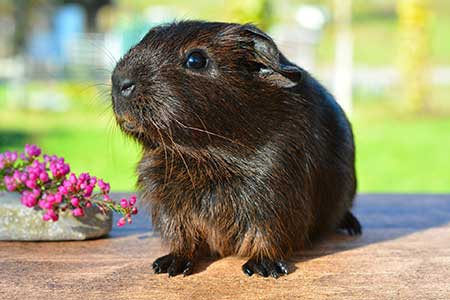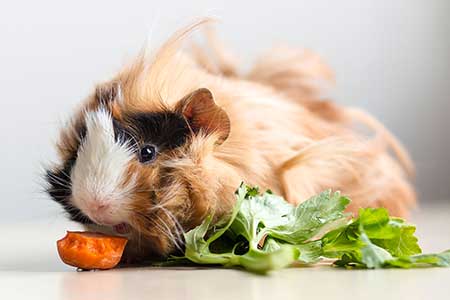Guinea Pigs
Basic Guinea Pig Care Guide
Guinea pigs are timid creatures but can become social pets with lots of care and low stress frequent handling. Read up on them to understand a little bit more about them and the care required for your future friend.
Why Guinea Pigs make fantastic pets!
Guinea pigs make ideal pets for numerous reasons - they are small, timid and social creatures. They require frequent low stress handling as they easily become stressed and any handling must be carefully done as they can easily get injured.
Guinea pigs will quickly associate you with the supplier of food and this aids them in becoming a social little animal. The lifespan of a pet guinea pig is commonly between five and seven years and there are many different varieties of guinea pig to choose from.
While all guinea pigs need a health check each day, the longer coat varieties require daily grooming so please be wary of this when picking out your guinea pigs.

What should you feed your guinea pig?
A guinea pig’s diet should be high in fibre with the staple of the diet being made up of high quality hay as well as fresh fruit and vegetables and a guinea pig specific diet. As well as this they should be receiving fresh water daily.
Guinea pigs, like humans, cannot create their own vitamin C so this should be supplied through fresh vegetables high in vitamin C such as carrots (including the tops), beans, silverbeet and cabbage.
With guinea pigs it is very important to ensure that the commercial diet you feed them is specific to guinea pigs to ensure vitamin C levels required for a healthy diet are met - a dry pellet diet rabbit specific food will not provide everything they need.
Their diet should have a balance of approximately 60% hay, 30% guinea pig commercial pellets and 10% vegetables and fruit. If you are unsure whether you can feed something ask your vet or an expert whether it is safe to feed.
Creating & maintaining a stimulating, clean environment:
- In creating suitable enclosures for a guinea pig, you must ensure that you first select the correct enclosure. This set up should be designed around whether it will be an indoor or outdoor guinea pig and considering how often you are going to be able to get it out for handling and exercise.
- Guinea pigs enjoy a large exercise area and a bedding area with lots of hay for warmth and nesting.
- If the cage has a wire bottom it should be covered in a bedding to prevent pressure sores from occurring.
- Bedding should have a base of wood shavings topped with hay for warmth for them to cuddle in to.
- Guinea pigs can be indoor or outdoor but should be kept in a sheltered spot – in winter please be wary of how cold it is and bring them in on frosty nights.
- To make sure the enclosure is stimulating for the guinea pig you should arrange it so there are a variety of areas for playing with different areas to explore.
- They enjoy tunnels, wooden ramps into different areas of the enclosure and food being made more challenging to reach by hanging and or rotating locations.
- The cage should be cleaned out twice weekly to ensure the cage smells fresh with bedding materials being replaced. When cleaning out the cage it is also advised to rearrange it slightly or rotate different toys in order to avoid boredom and keep your guinea pig happy and stimulated.
Should you have more than one guinea pig?
Guinea pigs are naturally social animals so it is best to have more than one. With guinea pigs, ensure that you keep them in same sex pairs as they are prolific breeders. It is best to get two when they are young and already together to ensure everything goes smoothly. Introducing guinea pigs must be a slow and patient process. Allow at least a month and have a cage for each, have the cages side by side and only ever introduce them supervised and in a neutral territory.
Keeping rabbits and guinea pigs together as pets can sometimes work, however this is not recommended. If you choose to do this do not place a unneutered male rabbit in with guinea pigs of either sex as his drive to mate will take over and the poor guinea pigs will not be left alone.
Future Owner List:
- A cage with plenty of room (it should have an area for sleeping and an exercise area)
- Fresh fruit and vegetables daily (read on for more information)
- Food bowl
- Drink bottle
- Guinea pig specific food
- Bedding for the base of the cage (Meadow hay and we recommend sticking a base of pine shavings underneath this)
- Tunnel and/or other interactive toy for stimulation
- Wood chew
- Salt lick
- Plenty of love and play time to enjoy this adorable little animal

Top tips…
- Do a daily health check of your guinea pig including skin condition and check for discharges from the eyes, ears and nose. The best way to pick up when something is wrong is to get to know what is normal for your guinea pig.
- Guinea pigs have incisors that grow constantly throughout their life so a wood chew to gnaw on is essential to keep the length of these down.
- Remember, anything that goes into the cage will be chewed so be careful of the toxicity of that is given to them.
- Make sure that they have lots of snug places to hide away so they can feel safe and secure.
- The more you play with your guinea pig, the calmer and more trusting it will become. They easily become stressed so be calm and patient.
- Always be patient with your guinea pigs. They are flight animals but with constant handling you will have your own guinea pig friend.
- Take good care of your pet guinea pig and they will provide you with plenty of entertainment!
13250